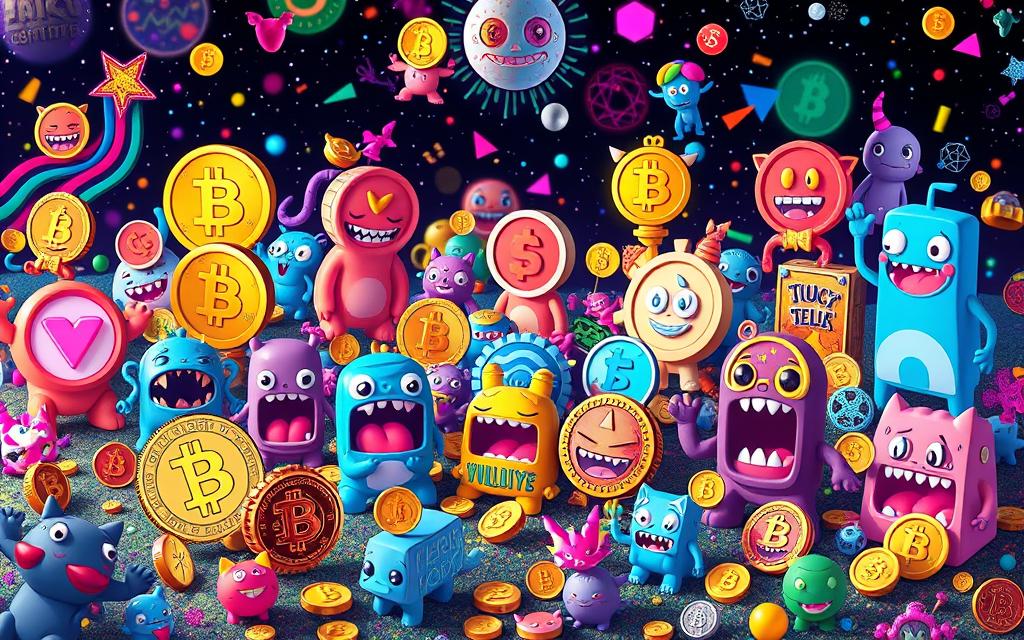Every day, thousands of new cryptocurrencies are launched. This makes the digital currency world change fast. You might know there are many kinds of cryptocurrencies. But did you know they can be grouped into categories like payment cryptocurrencies, utility tokens, stablecoins, and central bank digital currencies?
These types of cryptocurrencies, also known as digital currency or crypto coins, are changing how we think about money. They’re changing how we do financial transactions.
Exploring digital currencies, you’ll find each type has its own special features and uses. For example, payment cryptocurrencies like Bitcoin are made for buying and selling things. On the other hand, utility tokens like Ether are used for many things, like paying fees and building apps.
It’s important to know about these different cryptocurrencies. This knowledge helps you understand the complex world of digital currency and crypto coins.

As you learn more about digital currencies, you’ll discover their history, growth, and role in finance. Whether you’re interested in payment cryptocurrencies, utility tokens, or other digital currencies, this journey will show you how crypto coins are shaping the future of finance.
Introduction to the World of Digital Currencies
Exploring digital currencies opens up a world of blockchain assets and virtual coins. These are changing how we see money. Now, people and businesses can use cryptocurrency options for services and products they couldn’t before.
Digital currencies are only online and need devices like computers or phones to use. This has made digital wallets very popular, with over 70 million worldwide. They offer cheap and fast transactions, cutting out the middlemen.
What Defines a Cryptocurrency
A cryptocurrency is a type of digital currency. But not all digital currencies are cryptocurrencies. Cryptocurrencies are unique because they’re not controlled by governments or banks. This is thanks to blockchain technology, which makes transactions safe and open.
The Evolution of Digital Money
Digital money has grown fast, with new cryptocurrency options popping up all the time. From Bitcoin’s start to today’s blockchain assets and virtual coins, the digital currency world keeps changing. As you explore, knowing about decentralization, cryptography, and consensus is key.
Key Components of Cryptocurrencies
Some important parts of cryptocurrencies are:
- Decentralization: Cryptocurrencies aren’t controlled by governments or banks.
- Cryptography: They use strong cryptography to keep transactions safe.
- Consensus mechanisms: These help verify transactions and keep the network honest.
Bitcoin: The Pioneer of Cryptocurrencies
Exploring cryptocurrency varieties means starting with Bitcoin. It’s the first and most famous one. Created in 2009 by Satoshi Nakamoto, Bitcoin opened the door for other cryptos.
Bitcoin lets people make transactions directly with each other, without middlemen. It has only 21 million coins, making it valuable. Its security comes from advanced cryptography and a clear ledger system.
Some key features of Bitcoin include:
- Decentralized nature, allowing for peer-to-peer transactions
- Limited supply of 21 million coins, driving its value
- Advanced security features, such as cryptography and a transparent ledger system
As the first, Bitcoin has inspired many other cryptos. Each has its own special features and uses.

Common Types of Cryptocurrencies in Today’s Market
Exploring digital currency reveals many types of cryptocurrencies. Each has its own features and uses. The market is rich with altcoins, offering a variety for investors and users. We’ll look at common types, like payment coins, platform coins, utility tokens, and security tokens.
Payment coins, like Bitcoin and Litecoin, are made for fast, secure transactions. Platform coins, such as Ethereum, help developers build digital projects. This lets them create and run their own digital currency projects.
Key Characteristics of Cryptocurrencies
- Payment-focused coins: designed for transactions and medium of exchange
- Platform cryptocurrencies: support decentralized application development
- Utility tokens: used for specific purposes, such as transaction fees and computational services
- Security tokens: represent ownership or investment in a particular asset or project
Knowing about these types helps you understand the digital currency market. It’s key to stay updated on altcoins and digital currency trends. This knowledge aids in making smart choices about your investments.

Understand Altcoins and Their Purpose
When you dive into the world of types of cryptocurrencies, you’ll find altcoins. These are not Bitcoin but other cryptocurrencies. There are thousands of altcoins, each with its own features and benefits.
Some altcoins aim to fix problems in current crypto coins. For example, Ethereum has smart contract features. This lets people build apps without a central authority. Stablecoins, on the other hand, try to keep prices stable like cash.
Here are some key facts about altcoins:
- Altcoins can be used for various purposes, including payments, smart contracts, and decentralized applications.
- The altcoin market is often characterized by lower popularity, thinner liquidity, and smaller market caps compared to Bitcoin.
- Investment decisions involving altcoins can be complicated due to the wide variety and unique use cases they present.

Altcoins, or alternative coins, are any type of cryptocurrency that is not Bitcoin. These coins can vary greatly in terms of their technology, purpose, and value. While some altcoins are simply variations of Bitcoin, others are built on completely different blockchain platforms with unique features and capabilities.
One of the main purposes of altcoins is to address some of the limitations of Bitcoin. For example, while Bitcoin transactions can be slow and expensive, some altcoins offer faster and more affordable transactions. Additionally, some altcoins aim to provide solutions to specific industries or problems, such as privacy concerns or supply chain management.
Investing in altcoins can be a risky endeavor, as their prices can be highly volatile and their value can fluctuate dramatically. However, many investors see potential in altcoins as they offer different opportunities for growth and innovation within the cryptocurrency space.
Understanding different types of cryptocurrencies is crucial. It helps you make smart choices in the market. With altcoins, the future of cryptocurrencies looks bright and full of possibilities.

Stablecoins: The Bridge Between Crypto and Traditional Finance
When you look into cryptocurrency, you’ll find stablecoins. They keep their value stable, often tied to the US dollar. This helps reduce the ups and downs of crypto and acts as a safe place to keep value. Stablecoins are a big deal in the crypto world, with over $150 billion in value as of 2023.
Stablecoins are great for making transactions and keeping your money safe. They’re tied to real things like the US dollar or gold. This makes them a good choice for those who want to invest in crypto but don’t want too much risk. They’re also key in DeFi, helping people make digital payments who can’t use traditional banks.

Stablecoins offer many benefits. They have low fees and fast transactions. For example, their fees can be as low as $0.01, much cheaper than banks. Also, transactions are confirmed in under 10 minutes, unlike banks which can take days.
There are many types of stablecoins, each with its own features. Some are backed by fiat currency, like Tether (USDT) and USD Coin (USDC). Others are backed by other cryptocurrencies, which can be riskier. Knowing about these different stablecoins helps you make smart choices in the crypto world.
In the rapidly evolving landscape of cryptocurrencies, stablecoins have emerged as a crucial bridge between the world of digital assets and traditional finance. These digital assets are designed to maintain a stable value by pegging their value to a reserve asset, such as a fiat currency like the US dollar or a commodity like gold. This stability makes stablecoins an attractive option for investors looking to minimize the volatility often associated with other cryptocurrencies.
There are several types of stablecoins, each with its own unique characteristics and use cases. The most common types include:
1. Fiat-collateralized stablecoins: These stablecoins are backed by a reserve of fiat currency held in a bank account or other secure asset. Examples of fiat-collateralized stablecoins include Tether (USDT) and USD Coin (USDC).
2. Crypto-collateralized stablecoins: These stablecoins are backed by a reserve of other cryptocurrencies, such as Ether or Bitcoin. The value of the stablecoin is maintained by over-collateralizing the reserve assets. Examples of crypto-collateralized stablecoins include Dai and sUSD.
3. Algorithmic stablecoins: These stablecoins use algorithms to automatically adjust the supply of the coin in response to changes in demand, in order to maintain a stable value. Examples of algorithmic stablecoins include TerraUSD and Ampleforth.
4. Commodity-collateralized stablecoins: These stablecoins are backed by a reserve of a physical asset, such as gold or silver. The value of the stablecoin is tied to the value of the underlying commodity. Examples of commodity-collateralized stablecoins include Paxos Gold (PAXG) and Digix Gold (DGX).
Each type of stablecoin has its own advantages and disadvantages, and investors should carefully consider their goals and risk tolerance when selecting a stablecoin to invest in. With their ability to provide stability in a volatile market, stablecoins are playing an increasingly important role in bridging the gap between the world of cryptocurrencies and traditional finance.

DeFi Tokens and Their Growing Importance
Exploring cryptocurrency varieties, you’ll find DeFi tokens are key. They’re built on blockchain and used in lending, borrowing, and trading. Most DeFi apps run on Ethereum, with coins like Maker and Uniswap being popular.
DeFi tokens have many uses. They can represent assets, grant access, or be unique digital items. For example, some tokens manage lending platforms, while others create NFTs. Hundreds of apps now use DeFi tokens for lending, farming, and more.
Some key traits of DeFi tokens include:
- Decentralized and open-source
- Built on blockchain technology
- Used for various financial applications
- Can represent physical assets or unique digital items

DeFi tokens are getting more important as the crypto market grows. With over $105 billion in TVL, their role is clear. If you’re into crypto or DeFi, knowing the benefits and risks is crucial.
Decentralized Finance, or DeFi, has been gaining significant attention in the financial world in recent years. With its promise of open, permissionless, and transparent financial services, DeFi has the potential to revolutionize how we interact with money and the financial system as a whole. One of the key components of DeFi is the use of tokens, which serve as the building blocks of the ecosystem.
DeFi tokens are digital assets that represent ownership or participation in a decentralized network or protocol. These tokens can have various uses within the DeFi ecosystem, such as governance rights, staking, providing liquidity, and more. As the popularity of DeFi continues to grow, so does the importance of these tokens.
One of the main reasons for the growing importance of DeFi tokens is their role in enabling the various functions and services that DeFi platforms offer. For example, users can earn yield by providing liquidity to decentralized exchanges, or participate in decentralized governance by holding a certain amount of tokens. These tokens also serve as a way to incentivize users to participate in the network and help secure it.
Moreover, the value of DeFi tokens is often tied to the success and adoption of the underlying protocols and networks. As more users and assets flow into DeFi, the demand for these tokens increases, leading to potential price appreciation. This has led to the emergence of a vibrant DeFi token market, where investors can trade and speculate on the value of these tokens.
In addition, DeFi tokens play a crucial role in democratizing access to financial services. With traditional finance often serving as a barrier for many individuals around the world, DeFi tokens offer a way for anyone with an internet connection to participate in a wide range of financial activities, from borrowing and lending to trading and investing.
As the DeFi ecosystem continues to evolve and grow, the importance of these tokens is only set to increase. Whether you are a developer building on top of a DeFi protocol, an investor looking to profit from the burgeoning DeFi market, or simply someone interested in exploring the potential of decentralized finance, understanding and interacting with DeFi tokens is essential.
Privacy Coins: Understand Anonymous Cryptocurrencies
When you dive into the digital currency world, you might find altcoins that promise anonymity. These privacy coins aim to keep your financial dealings secret. They use special tech like ring signatures and zero-knowledge proofs to hide who’s making a transaction.
Monero, Zcash, and Dash are some well-known privacy coins. They’re popular because they let you make secret transactions. This is something Bitcoin can’t do. Their complex tech ensures your money moves are safe and private.

In the market, there are many privacy coins, each with its own perks. For instance, Monero hides user identities with ring signatures. Zcash uses zero-knowledge proofs to check transactions without sharing details. As more people want private digital money, these coins are becoming more popular.
Some notable examples of privacy coins include:
- Monero (XMR)
- Zcash (ZEC)
- Dash (DASH)
These coins are known for their ability to keep transactions secret. Their value is growing. When looking at digital currency options, it’s key to know what privacy coins offer. They can help keep your financial life private.
One of the key features of privacy coins is the use of advanced cryptography techniques to obfuscate transaction details. This includes techniques such as ring signatures, stealth addresses, and zero-knowledge proofs. These technologies ensure that the sender, recipient, and amount of the transaction remain private and untraceable.
Privacy coins have gained popularity among individuals who value their financial privacy and want to keep their transactions confidential. These coins are particularly popular among users who engage in sensitive or illegal activities, as they provide a secure and private way to transfer funds without fear of surveillance.
However, privacy coins have also come under scrutiny from regulatory authorities and law enforcement agencies due to their potential use in illegal activities such as money laundering and tax evasion. As a result, some cryptocurrency exchanges have delisted privacy coins or imposed additional regulations on their use.
Despite these challenges, privacy coins continue to play a significant role in the cryptocurrency market. As users become more aware of the importance of financial privacy, the demand for these coins is expected to grow. It is important for individuals to understand the benefits and risks associated with privacy coins and to use them responsibly to protect their privacy while complying with legal regulations.

Meme Coins and Community-Driven Cryptocurrencies
When you look into different cryptocurrencies, you might find meme coins. These are often made as jokes or to follow a trend. They have a big and active community, which makes them popular.
Dogecoin, Shiba Inu, and Pepe are examples of meme coins. They started as jokes but now have a big market value. Social tokens have also led to more community-driven cryptocurrencies. These often get a lot of attention on social media and can be boosted by famous people.
Meme coins are known for being very volatile and having low liquidity. They don’t really have a purpose other than for fun. But, they can be tempting to investors because they are cheap and might make a lot of money. It’s important to be careful with meme coins because their value can change a lot based on what people say online.

Understanding meme coins and community-driven cryptocurrencies is key. Knowing the risks and chances can help you make better choices. By doing your homework and staying up-to-date, you can avoid problems and make smart investments.
Meme coins, as the name suggests, are cryptocurrencies that are often based on internet memes or jokes. These coins typically have no real-world utility or use case, and their value is largely driven by social media hype and speculation. Some famous examples of meme coins include Dogecoin, Shiba Inu, and SafeMoon.
On the other hand, community-driven cryptocurrencies are projects that are developed and maintained by a decentralized community of developers, users, and supporters. These coins often have a specific use case or utility, and their value is determined by the strength and commitment of the community behind them. Examples of community-driven cryptocurrencies include Ethereum, Cardano, and Polkadot.
One of the key differences between meme coins and community-driven cryptocurrencies is their long-term sustainability and viability. While meme coins may experience short-term spikes in value due to social media trends, they often lack a solid foundation and are prone to sharp price crashes. In contrast, community-driven cryptocurrencies are built on strong technology and have a dedicated community backing them, which can help ensure their longevity and success in the long run.
Ultimately, both meme coins and community-driven cryptocurrencies have their place in the cryptocurrency market, and investors should carefully research and consider the risks and potential rewards of each before making any investment decisions. Whether you’re looking for a fun and speculative investment or a more stable and sustainable option, the world of cryptocurrency offers a wide range of choices to suit your needs and preferences.

NFT-Related Cryptocurrencies and Digital Asset Tokens
Exploring digital assets leads to unique blockchain assets called non-fungible tokens (NFTs). These virtual coins show ownership of special items like art, collectibles, or even real estate. The rise of NFTs has created a new type of cryptocurrency, allowing users to safely buy, sell, and store these digital assets.
The NFT market has seen rapid growth, with over $11.1 billion in sales in 2023. This market is expected to keep growing, possibly reaching $80 billion by 2025. As the blockchain world grows, more unique digital assets will be available, offering a variety of cryptocurrency options for investors and collectors.
Examples of NFTs include digital art, rare collectibles, and even unique physical items like a 2,000-pound tungsten cube. Blockchain technology ensures these digital assets are stored and traded securely. This makes it appealing for those interested in investing in virtual coins and other cryptocurrency options.

NFTs are unique digital assets that are stored on a blockchain and cannot be replicated or duplicated. These tokens can represent a wide range of digital or physical assets, such as art, music, collectibles, and even virtual real estate. In contrast to fungible tokens like Bitcoin and Ethereum, which are interchangeable and have the same value, NFTs are one-of-a-kind assets that have their own distinct value.
With the rise of NFTs, there has also been a surge in the development of NFT-related cryptocurrencies and digital asset tokens. These tokens are designed to facilitate transactions and interactions within the NFT ecosystem, providing users with a way to buy, sell, and trade NFTs securely and efficiently.
One of the most well-known NFT-related cryptocurrencies is Enjin Coin (ENJ), which is a token built on the Ethereum blockchain that is used to purchase and sell virtual goods and NFTs within the Enjin ecosystem. Another popular example is Decentraland (MANA), a virtual world built on the Ethereum blockchain where users can buy, sell, and trade virtual real estate and assets using the MANA token.
As the popularity of NFTs continues to grow, so too will the demand for NFT-related cryptocurrencies and digital asset tokens. These tokens play a crucial role in the NFT ecosystem, providing users with the tools and infrastructure needed to participate in this exciting new digital asset class.
Overall, NFT-related cryptocurrencies and digital asset tokens offer a unique opportunity for investors and enthusiasts to get involved in the rapidly expanding world of NFTs. Whether you’re a seasoned cryptocurrency investor or a newcomer looking to explore this new frontier, there’s no denying that NFTs and their related tokens are here to stay.
The growing popularity of NFTs and digital asset tokens is because they can represent ownership and provenance of unique items. As the market expands, understanding these blockchain assets is crucial. This knowledge helps you navigate the world of cryptocurrency options and make smart investment choices.
The Future Landscape of Digital Currencies
The world of and is changing fast. It’s shaped by new tech, rules, and what people want. Even though the future is unsure, digital currencies will keep being important worldwide.
Bitcoin, the first digital currency, has seen big success. Its value has gone over $1 trillion. But, the market is very unstable, with Bitcoin’s price changing a lot. As more and come out, people will have to be careful. They need to think about the risks and the chances of making money.
The future of digital money will depend on many things. This includes rules and how many people use them. By keeping up and being flexible, you can do well in this changing world. The growing world of and offers chances for success.

Source Links
- Types of Cryptocurrency – https://corporatefinanceinstitute.com/resources/cryptocurrency/types-of-cryptocurrency/
- 10 Popular Types of Cryptocurrency and How They Work – https://n26.com/en-eu/blog/types-of-cryptocurrency
- Digital Currency Types, Characteristics, Pros & Cons, Future Uses – https://www.investopedia.com/terms/d/digital-currency.asp
- Digital Currencies | Explainer | Education – https://www.rba.gov.au/education/resources/explainers/cryptocurrencies.html
- Bitcoin – https://en.wikipedia.org/wiki/Bitcoin
- 10 Important Cryptocurrencies Other Than Bitcoin – https://www.investopedia.com/tech/most-important-cryptocurrencies-other-than-bitcoin/
- Cryptocurrency – https://en.wikipedia.org/wiki/Cryptocurrency
- 12 Most Popular Types Of Cryptocurrency | Bankrate – https://www.bankrate.com/investing/types-of-cryptocurrency/
- 10 Popular Cryptocurrencies & Their Use Cases | Caleb & Brown – https://calebandbrown.com/blog/types-of-crypto/
- Altcoin Explained: Pros and Cons, Types, and Future – https://www.investopedia.com/terms/a/altcoin.asp
- 6 Types of Altcoins and Their Use Cases | Caleb & Brown – https://calebandbrown.com/blog/altcoins/
- Stablecoins: The bridge between traditional finance and cryptocurrency – Simplex – https://www.simplex.com/stablecoins-the-bridge-between-traditional-finance-and-cryptocurrency
- Stablecoins: The Bridge Between Traditional Finance and Cryptocurrency Explained – https://coinpaper.com/4638/stablecoins-bridge-tradifi-crypto
- Understanding Stablecoins: The Bridge Between Crypto and Traditional Finance – TheCryptoUpdates – https://www.thecryptoupdates.com/understanding-stablecoins-the-bridge-between-crypto-and-traditional-finance/
- DeFi Coins and Tokens: What Every Investor Should Know – https://www.kubera.com/blog/defi-coins
- What Is Decentralized Finance (DeFi) and How Does It Work? – https://www.investopedia.com/decentralized-finance-defi-5113835
- Cryptocurrency’s Decentralized Finance (DeFi): Current Landscape – https://econone.com/resources/blogs/cryptocurrency-decentralized-finance-defi-current-landscape/
- Privacy Coins 101: Anonymity-Enhanced Cryptocurrencies – Chainalysis – https://www.chainalysis.com/blog/privacy-coins-anonymity-enhanced-cryptocurrencies/
- Top Privacy Coins & Privacy-Oriented Crypto Tokens (2025) – https://www.bitdegree.org/crypto/tutorials/top-privacy-coins
- Meme Coins: What They Are, Examples, Pros and Cons – https://www.investopedia.com/meme-coin-6750312
- Meme Coins: Definition & Characteristics – https://www.bitpanda.com/academy/en/lessons/meme-coins-definition-and-characteristics
- Meme Coins: The Rise of Fun and Community-Driven Cryptocurrencies – https://medium.com/@ivandcrypto/meme-coins-the-rise-of-fun-and-community-driven-cryptocurrencies-e89dbe93966e
- Digital Assets: Cryptocurrencies vs. Crypto Tokens | Gemini – https://www.gemini.com/cryptopedia/cryptocurrencies-vs-tokens-difference
- Demystifying cryptocurrency and digital assets – https://www.pwc.com/us/en/tech-effect/emerging-tech/understanding-cryptocurrency-digital-assets.html
- NFTs, Cryptocurrencies and Crypto Assets Explained – https://www.bracheichler.com/insights/nfts-cryptocurrencies-and-crypto-assets-explained/
- The Future Of Cryptocurrency – https://www.investopedia.com/articles/forex/091013/future-cryptocurrency.asp
- The Future of Crypto: Why Smart Investors Are Backing the Ecosystem – https://www.ssga.com/us/en/individual/insights/the-future-of-crypto-why-smart-investors-are-backing-the-ecosystem
- Cryptocurrencies, Digital Dollars, and the Future of Money – https://www.cfr.org/backgrounder/crypto-question-bitcoin-digital-dollars-and-future-money



